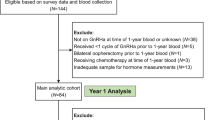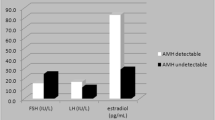Abstract
Young women with breast cancer face treatments that impair ovarian function, but it is not known if malignancy itself impacts ovarian reserve. As more breast cancer patients consider future fertility, it is important to determine if ovarian reserve is impacted by cancer, prior to any therapeutic intervention. A cross-sectional study was conducted comparing if ovarian reserve, as measured by anti-mullerian hormone (AMH), follicle stimulating hormone (FSH), and inhibin B (inhB), differed between 108 women with newly diagnosed breast cancer and 99 healthy women without breast cancer. Breast cancer participants were ages 28–44 and were recruited from two clinical breast programs. Healthy women ages 30–44 without a history of infertility were recruited from gynecology clinics and the community. The median age (interquartile range) was 40.2(5.5) years for breast cancer participants and 33.0(4.6) years for healthy controls. The unadjusted geometric mean AMH levels (SD) for breast cancer participants and controls were 0.66(3.6) and 1.1(2.9) ng/mL, respectively. Adjusting for age, body mass index, gravidity, race, menstrual pattern, and smoking, mean AMH levels were not significantly different between breast cancer participants and healthy controls (0.85 vs. 0.76 ng/mL, p = 0.60). FSH and inhB levels did not differ by breast cancer status. In exploratory analysis, the association between AMH and breast cancer status differed by age (p-interaction = 0.02). AMH may be lower with breast cancer status in women older than 37. In younger women, AMH levels did not differ significantly by breast cancer status. Among the youngest of breast cancer patients, ovarian reserve as measured by AMH, FSH, and inhibin B did not differ significantly from healthy women of similar age. In older breast cancer patients, ovarian reserve may be adversely impacted by cancer status. These findings support the potential success and need for fertility preservation strategies prior to institution of cancer treatment.

Similar content being viewed by others
Explore related subjects
Discover the latest articles and news from researchers in related subjects, suggested using machine learning.References
DevCan: Probability of Developing or Dying of Cancer Software VSRaABNCI, 2012. www.srab.cancer.gov/devcan
Warne GL, Fairley KF, Hobbs JB, Martin FI (1973) Cyclophosphamide-induced ovarian failure. N Engl J Med 289(22):1159–1162
Anderson RA, Themmen AP, Al-Qahtani A, Groome NP, Cameron DA (2006) The effects of chemotherapy and long-term gonadotrophin suppression on the ovarian reserve in premenopausal women with breast cancer. Hum Reprod 21(10):2583–2592
Su HI, Sammel MD, Green J, Velders L, Stankiewicz C, Matro J, Freeman EW, Gracia CR, DeMichele A (2010) Antimullerian hormone and inhibin B are hormone measures of ovarian function in late reproductive-aged breast cancer survivors. Cancer 116(3):592–599
Partridge AH, Gelber S, Peppercorn J, Ginsburg E, Sampson E, Rosenberg R, Przypyszny M, Winer EP (2008) Fertility and menopausal outcomes in young breast cancer survivors. Clin Breast Cancer 8(1):65–69
Schover LR (2008) Premature ovarian failure and its consequences: vasomotor symptoms, sexuality, and fertility. J Clin Oncol 26(5):753–758
Bahadur G, Ozturk O, Muneer A, Wafa R, Ashraf A, Jaman N, Patel S, Oyede AW, Ralph DJ (2005) Semen quality before and after gonadotoxic treatment. Hum Reprod 20(3):774–781
Bahadur G, Ling KL, Hart R, Ralph D, Wafa R, Ashraf A, Jaman N, Mahmud S, Oyede AW (2002) Semen quality and cryopreservation in adolescent cancer patients. Hum Reprod 17(12):3157–3161
Su HI (2010) Measuring ovarian function in young cancer survivors. Minerva Endocrinol 35(4):259–270
Broekmans FJ, Kwee J, Hendriks DJ, Mol BW, Lambalk CB (2006) A systematic review of tests predicting ovarian reserve and IVF outcome. Hum Reprod Update 12(6):685–718
Hendriks DJ, Kwee J, Mol BW, te Velde ER, Broekmans FJ (2007) Ultrasonography as a tool for the prediction of outcome in IVF patients: a comparative meta-analysis of ovarian volume and antral follicle count. Fertil Steril 87(4):764–775
La Marca A, Broekmans FJ, Volpe A, Fauser BC, Macklon NS (2009) Anti-Mullerian hormone (AMH): what do we still need to know? Hum Reprod 24(9):2264–2275
Freeman EW, Sammel MD, Lin H, Gracia CR (2012) Anti-mullerian hormone as a predictor of time to menopause in late reproductive age women. J Clin Endocrinol Metab 97(5):1673–1680
La Marca A, Sighinolfi G, Radi D, Argento C, Baraldi E, Artenisio AC, Stabile G, Volpe A (2010) Anti-Mullerian hormone (AMH) as a predictive marker in assisted reproductive technology (ART). Hum Reprod Update 16(2):113–130
Knopman JM, Noyes N, Talebian S, Krey LC, Grifo JA, Licciardi F (2009) Women with cancer undergoing ART for fertility preservation: a cohort study of their response to exogenous gonadotropins. Fertil Steril 91(4 Suppl):1476–1478
Quintero RB, Helmer A, Huang JQ, Westphal LM (2010) Ovarian stimulation for fertility preservation in patients with cancer. Fertil Steril 93(3):865–868
Robertson AD, Missmer SA, Ginsburg ES (2011) Embryo yield after in vitro fertilization in women undergoing embryo banking for fertility preservation before chemotherapy. Fertil Steril 95(2):588–591
Pal L, Leykin L, Schifren JL, Isaacson KB, Chang YC, Nikruil N, Chen Z, Toth TL (1998) Malignancy may adversely influence the quality and behaviour of oocytes. Hum Reprod 13(7):1837–1840
Domingo J, Guillen V, Ayllon Y, Martinez M, Munoz E, Pellicer A, Garcia-Velasco JA (2012) Ovarian response to controlled ovarian hyperstimulation in cancer patients is diminished even before oncological treatment. Fertil Steril 97(4):930–934
Freeman EW, Gracia CR, Sammel MD, Lin H, Lim LC, Strauss JF 3rd (2007) Association of anti-mullerian hormone levels with obesity in late reproductive-age women. Fertil Steril 87(1):101–106
Efron BT, Tibshirani RJ (1994) An introduction to the bootstrap. CRC Press, Boca Raton
Steiner AZ, Herring AH, Kesner JS, Meadows JW, Stanczyk FZ, Hoberman S, Baird DD (2010) Antimullerian hormone as a predictor of natural fecundability in women aged 30–42 years. Obstet Gynecol 117(4):798–804
Das M, Shehata F, Moria A, Holzer H, Son WY, Tulandi T (2011) Ovarian reserve, response to gonadotropins, and oocyte maturity in women with malignancy. Fertil Steril 96(1):122–125
Moria A, Das M, Shehata F, Holzer H, Son WY, Tulandi T (2011) Ovarian reserve and oocyte maturity in women with malignancy undergoing in vitro maturation treatment. Fertil Steril 95(5):1621–1623
Yu B, Douglas N, Ferin MJ, Nakhuda GS, Crew K, Lobo RA, Hershman DL (2010) Changes in markers of ovarian reserve and endocrine function in young women with breast cancer undergoing adjuvant chemotherapy. Cancer 116(9):2099–2105
Lawrenz B, Fehm T, von Wolff M, Soekler M, Huebner S, Henes J, Henes M (2012) Reduced pretreatment ovarian reserve in premenopausal female patients with Hodgkin lymphoma or non-Hodgkin-lymphoma-evaluation by using antimullerian hormone and retrieved oocytes. Fertil Steril 98(1):141–144
Plante BJ, Cooper GS, Baird DD, Steiner AZ (2010) The impact of smoking on antimullerian hormone levels in women aged 38–50 years. Menopause 17(3):571–576
Hehenkamp WJ, Volkers NA, Broekmans FJ, de Jong FH, Themmen AP, Birnie E, Reekers JA, Ankum WM (2007) Loss of ovarian reserve after uterine artery embolization: a randomized comparison with hysterectomy. Hum Reprod 22(7):1996–2005
La Marca A, Stabile G, Artenisio AC, Volpe A (2006) Serum anti-Mullerian hormone throughout the human menstrual cycle. Hum Reprod 21(12):3103–3107
Tsepelidis S, Devreker F, Demeestere I, Flahaut A, Gervy C, Englert Y (2007) Stable serum levels of anti-Mullerian hormone during the menstrual cycle: a prospective study in normo-ovulatory women. Hum Reprod 22(7):1837–1840
Li HW, Anderson RA, Yeung WS, Ho PC, Ng EH (2011) Evaluation of serum antimullerian hormone and inhibin B concentrations in the differential diagnosis of secondary oligoamenorrhea. Fertil Steril 96(3):774–779
Nelson SM, La Marca A (2012) The journey from the old to the new AMH assay: how to avoid getting lost in the values. Reprod Biomed Online 23(4):411–420
Kumar A, Kalra B, Patel A, McDavid L, Roudebush WE (2010) Development of a second generation anti-Mullerian hormone (AMH) ELISA. J Immunol Methods 362(1–2):51–59
Lee JR, Kim SH, Jee BC, Suh CS, Kim KC, Moon SY (2011) Antimullerian hormone as a predictor of controlled ovarian hyperstimulation outcome: comparison of two commercial immunoassay kits. Fertil Steril 95(8):2602–2604
Streuli I, Fraisse T, Chapron C, Bijaoui G, Bischof P, de Ziegler D (2009) Clinical uses of anti-Mullerian hormone assays: pitfalls and promises. Fertil Steril 91(1):226–230
Freour T, Mirallie S, Bach-Ngohou K, Denis M, Barriere P, Masson D (2007) Measurement of serum anti-Mullerian hormone by Beckman Coulter ELISA and DSL ELISA: comparison and relevance in assisted reproduction technology (ART). Clin Chim Acta 375(1–2):162–164
Acknowledgments
We are grateful to Minya Pu, MS, for her guidance in graph generation. The study was funded by the National Institute of Child Health and Human Development (HD058799 [IS], HD060229 [AS]) and the American Cancer Society (MRSG-08-110-01-CCE [IS]).
Conflict of interest
Anne Steiner has been a consultant for Roche Diagnostics. Angela DeMichele has been a consultant for Pfizer.
Ethical standards
The study complied with the current laws of the United States.
Author information
Authors and Affiliations
Corresponding author
Rights and permissions
About this article
Cite this article
Su, H.I., Flatt, S.W., Natarajan, L. et al. Impact of breast cancer on anti-mullerian hormone levels in young women. Breast Cancer Res Treat 137, 571–577 (2013). https://doi.org/10.1007/s10549-012-2361-5
Received:
Accepted:
Published:
Issue Date:
DOI: https://doi.org/10.1007/s10549-012-2361-5




